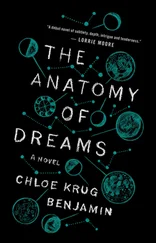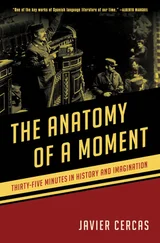“Ma!” yelled Jamie.
The mask was still on his face; he reached for it with his left hand, but Gabe was too quick. He grabbed the arm and held it back down to the bed.
“Sylvie, send the light stimulus,” said Keller, one hand at the top of Jamie’s head, the other at his chin. “Respond to him, Gabe. Try to calm him.”
I triggered the LEDs, and Jamie’s body paused in notice.
“Where?” asked Gabe. “Where do you see her?”
“There are so many stars,” said Jamie, his body tensing.
“That’s right,” said Gabe. “Do you remember what to do when you see stars?”
“At the window,” said Jamie. “I see her.”
Gabe looked at the window in Room 76, closed and barred as usual.
“What’s she doing?” asked Gabe.
“Climbing out,” said Jamie. “I lost her at the — supermarket.”
The mask had fallen halfway off his face, dangling over one eye. The exposed eye was still closed.
“At the supermarket?” Gabe asked, looking at Keller.
“No,” said Jamie. “We were — riding — on the train—”
The shaking began again, more violently than before, and Jamie screamed. His heart rate had skyrocketed, and the underarms of his pajamas were soaked in sweat. Keller strained to keep the boy’s head steady. He looked at the window between our rooms.
“Sylvie,” he said, “we need a current. Send it through F3 and F4.”
These were the electrodes attached to Jamie’s frontal lobe. I shook my head, though I knew he couldn’t see me. A current to the frontal lobe — this was an electrical shock, which would result in a real seizure, brief but shocking enough to wake Jamie up. I had been taught how to do it, but I’d never tried it on a patient.
“Sylvie,” Keller barked, his teeth gritted. I stood over the machines. The paper from the analog polysomnograph moved to the left as the pen made delicate markings, writing the story of Jamie’s brain.
“We need you to do it, Sylve,” said Gabe. He was holding Jamie’s ankles and looking at me in the way he so often did — with appeal so earnest it looked almost like love.
When I sent the shock, Jamie stiffened in Gabe and Keller’s hands as if suspended. Then, almost imperceptibly, he tucked into himself: his shoulders rose as his stomach dropped, his back rounding beneath it. Keller took off the mask, and the boy’s body went limp. He was facing away from me, but on the video camera, I could see his eyes begin to open.
It was barely ten. We called Rosemarie to take him home; the study had ended, so we couldn’t keep Jamie in the lab. While I put away the equipment in Room 74, Keller met them in the hall. It was impossible to tell how much Jamie remembered: he was woozy and confused, but he seemed to stare at the three of us with new distrust. He flinched, moving behind his grandmother, when Gabe tried to give him a pat on the head. Keller told Rosemarie we had been slightly premature: Jamie wasn’t ready; his lucidity skills would have to be worked on at home, and we could try again if he made progress. It wasn’t far from the truth — in fact, perhaps it was the truth exactly — but I still felt a long-dormant anger build inside me.
“You’re welcome to come back in six months,” Keller said, his voice muffled by the door. Through the sliver at the bottom, I could see Rosemarie’s orthopedic shoes and Jamie’s Velcro sneakers, the red bars on his heels that lit up as he walked away.
When I couldn’t hear their voices anymore, I rolled the cart into Room 76 to collect the electrodes. As I peeled off the white tape that had attached one of them to Jamie’s head, the electrode fell, hitting the floor with a metallic click.
When I tried again, the same thing happened. I looked down at my hands. They shuddered in a way I had never seen before, my fingers stiff and bony as twigs. I closed and opened them, but the quavering didn’t stop — not until I leaned against the wall with my eyes closed, arms limp at my sides, and breathed as slowly as I could.
By the time I walked into Keller’s office, half an hour had passed. I expected them to ask what had taken me so long, but Keller sat at his desk, finishing the summary report as usual. Gabe was on the floor, eating the last of his sandwich.
“Come back in six months?” I asked.
My voice was quiet, but I’d gotten their attention. Keller turned around in his chair, the wheels squealing on the floor.
“Is that a problem?” he asked.
“We just saw how damaged he is,” I said. “We watched him try to claw his way out of bed, we shocked him — and now we’re just going to send him home?”
I felt short of breath; I had never spoken to Keller this way before. I suppose I was worried he’d fire me. But a part of me knew that would be impossible for him, and that’s where I found my nerve.
“Sylvie,” said Keller, “the procedure tonight was no different than it is on any other night.”
“But on the other nights we were using adults. Teenagers, even.”
“We don’t use them,” said Keller. “We accept them as participants.”
I inhaled sharply, sucking in my mistake.
“We were accepting adults,” I said. “Not children. Jamie’s so vulnerable — his dreams are horrific. And we’re going to leave him like that?”
Keller looked at me closely, his hands crossed in his lap.
“Lucidity is the most basic demand of this study,” he said. “We make it very clear that every patient must meet the same requirement: if they aren’t dreaming lucidly within eight weeks, they can’t continue. No exceptions. Jamie didn’t qualify.”
“But that means we just lance the wound and leave it open. We help our patients remember what they’re dreaming, we intensify their experience of those dreams, and then we just leave them behind if they don’t make the cut?”
“I don’t understand why you find this so disturbing.” Keller spoke clinically, his hands crossed in his lap. “You’ve watched me release a number of patients early. You weren’t bothered by them.”
“Maybe it’s because Jamie’s a kid.” I felt checked and defensive. “He’s so impressionable, and he’s experienced more trauma than most adults. Besides, he’s in danger — if we hadn’t been here, he would have gotten out of bed and followed his parents right out of the window. He could have hurt himself.”
“No, he couldn’t have,” said Gabe. “The window is barred.”
I stared at him, wounded; I’d expected him to be on my side.
“Here it is,” I said. “Not at home.”
Keller eyed us briefly. Then he picked up the notepad on his desk and began to read aloud, Gabe transcribing the notes on his laptop.
“Patient three oh four, age seven, fifty inches tall, forty-eight pounds, came to the lab for his lucidity assessment following a diagnosis of night terrors and/or somnambulism. In one single-night study, patient three oh four exhibited a characteristic lack of paralysis, but he did not meet standards for lucidity. While claiming the presence of a female intruder, patient three oh four exhibited violent behavior—”
“Exactly,” I said.
“—exhibited violent behavior,” Keller said, continuing, “which included talking, yelling, punching, kicking, turning the head rapidly from side to side, attempting to escape his constraints—”
“Do you really think we have no obligation to help him?” My body was shot through with heat. “Who knows what’ll happen in the next six months?”
Keller sighed. He set the pad on his lap and looked at me with a parent’s tired patience.
“The focus of our research,” he said, “is lucidity. Our studies are short-term; our goal is the resolution of abnormal behavior during sleep. Yes, we want to encourage self-awareness. Yes, we hope that lucid dreaming will ultimately lead to deeper understanding and reduced anxiety, but we can’t guarantee it. It’s never been within our purview to meet those particular endpoints — we don’t have the funding to keep a psychoanalyst on hand, which is exactly why I always suggest that patients follow up with a mental health professional in their area. We make recommendations; that’s the best we can do.”
Читать дальше












